Fanghu Han Dynasty 206bc 220ad Chinese Bronze Ritual Wine Vessel Jug & Cover
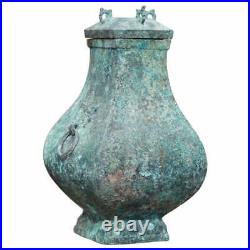
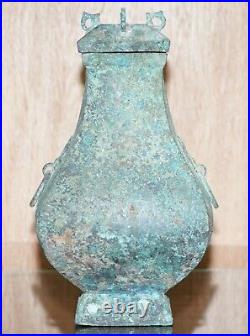
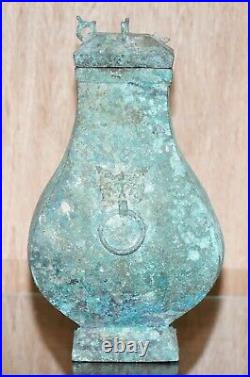

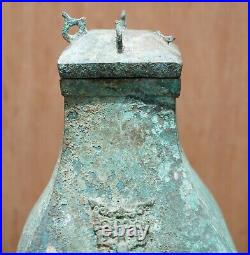

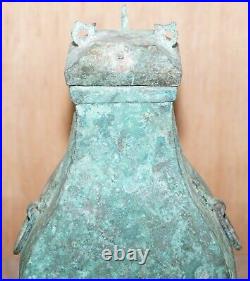
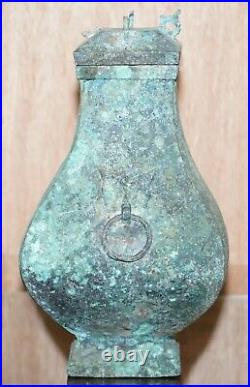
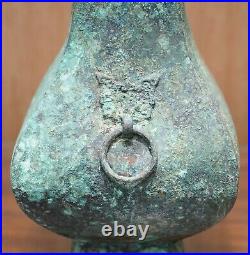
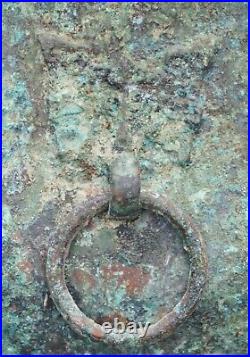
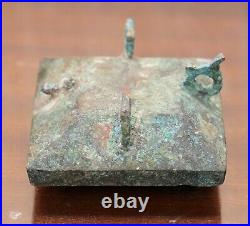
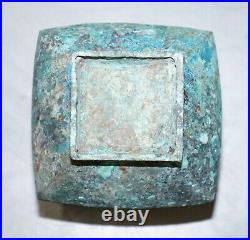

Royal House Antiques is delighted to offer for sale this exceptionally important and highly collectable museum quality original Chinese bronze ritual wine vessel and cover, Fanghu Han Dynasty 206BC - 220AD with Taotie mask handles - olive green and russet patina with specks of malachite encrustation. The quadrangular wine jar is raised on a high pyramidal foot. Two sides of the vessel are embellished with a crisply cast taotie-mask, through the nose of which a movable ring is placed. The mouth rim is accentuated with a narrow-raised band.
The square cover has a flat top, and each side is applied with a bird-form finial that convert to supports when the cover is inverted. The vase has an attractive olive-green and russet patina and has some bright specks of malachite encrustation. The patina and encrustation enhance the beauty of the vase and make it interesting to look at: each side has its own appearance. The taotie-mask is one of the most distinctive and characteristic images in Chinese art, originating from Shang ritual bronzes and becoming a much-used decoration in later dynasties: not only in bronze but also on other art-forms such as porcelain. The primary attribute of this frontal animal-like mask is a prominent pair of eyes, often protruding in high relief.
Between the eyes is a nose, often with nostrils at the base. Taotie can also include jaws and fangs, horns, ears, and eyebrows.
Many versions include a split animal-like body with legs and tail, each flank shown in profile on either side of the mask. While following a general form, the appearance and specific components of taotie masks varied by period and place of production. It is thought that the taotie is a protective symbol.It is likely that the present fanghu is applied with these masks to protect the deceased in his grave and on his journey to the spirit world. Please note all measurements are taken at the widest point, if you would like any additional or specific measurements please ask.
Not only bronze weapons were made with which the Shang and Zhou controlled peoples around them, but also much attention was paid by casters and their patrons to vessels in which food and wine were offered to ancestors. Most of these bronzes may be described as ritual vessels intended for the worship of ancestors, who are often named in inscriptions on the bronzes. These ritual vessels of ancient China represent possibly the most remarkable achievement in the whole history of metalcraft before modern times. Bronze vases should not be considered individually but in groups as ritual sets. These sets are defined as the range of vessel types required for the correct performance of rituals.
The combination of these vessels can be inferred from two sources - intact tomb groups and vessels that share a common dedication. From the arrangement and quantity of bronzes displayed in a given ceremony, one can discern the specific social status and position of that noble host. In the case of vessels interred in tombs it seems likely that the occupant of the tomb was expected to continue to offer sacrifices to his ancestors after his death and that vessels were buried for this purpose, even though he had become an ancestor himself. It is also possible that they were used at funerary rites.
Besides their use in ancestral worship, rites of spirit worship and as symbols of status and power, bronzes could, it was believed, when buried with the deceased, continue to serve in the afterlife. As some aristocrats and all commoners at the time could not afford the expense of bronzes, frequently complete sets of ritual vessels were made in fired pottery. Under the ultimate unification of Qin and Han, Chinese bronzes gradually yielded its central role in the ritual system but transformed into a cultural archetype. Although there are many different shapes in Chinese bronze ritual vessels, they can be reduced to a few essential types used for the ritual of ancestor worship. Vessels were required in which to cook and serve the dishes, to preserve and hold the wine for drinking, and to contain and pour water.
They can most simply be grouped according to their use in sacrifices. Hu: A round-bellied vase or a jar with a cover.
You: A ritual wine vessel with a stout oval body and an overhead handle, usually with a cover. Zun: Another ritual wine vessel, flared and with a bulbous mid-section. Gu: Also a ritual wine vessel, similar to the zun but with a slender silhouette. Jue: One of the more striking vessels of the archaic ritual bronze assembly - another ritual wine vessel, with a prominent spout, whorl-capped posts, flared tail and long tripod legs. Ding: A ritual cooking vessel with a globular body, tripod legs and a pair of upright handles.Gui: A ritual food vessel with a compressed globular body, raised on a waisted foot, with a pair of loop handles usually decorated with animal heads Square forms: Many of the standard shapes also appear in'square' or fang versions, including the fangzun, fanghu and fangding. Of great significance to the ancient ruling elites, square vessels are much rarer. Square-sectioned vessels have a more formal and regular appearance.
Today, we see the Chinese bronzes in a very different condition from the original. Their long period underground has covered them with a patina, sometimes rough with encrustations and sometimes smooth like jade. They take on all the shades of green. Often, there are russet, purple or blue patches depending on the chemical changes which affected the metal. These alterations only emphasise the beauty of these bronzes.
Royal House Antiques is a privately owned family ran business founded in Wimbledon SW19 and now based in Pulborough RH20. We specialise in finding, restoring very fine luxury antique leather seating, along with every single other type of antique ranging from the 16. We also stock a number of designer brands such as Fritz Hansen, Ralph Lauren, Cavalli, Charles & Ray Eames, Vitra, David Linley, Rolex, Tiffany, Jager Le Coulter and so on. Please view the very detailed pictures as they form part of the description pertaining to the condition.Royal House Antiques cannot be held liable for any independent assumptions made regarding the items we sell, if you are unsure on any point, please feel free to ask for clarity. Please note vintage period and original items such as leather seating will always have natural patina in the form of creasing and wear, we recommend annual waxing to ensure no moisture is lost, also hand dyed leather is not recommended to sit in direct sunlight for prolonged periods of time as it will dry out and fade.
